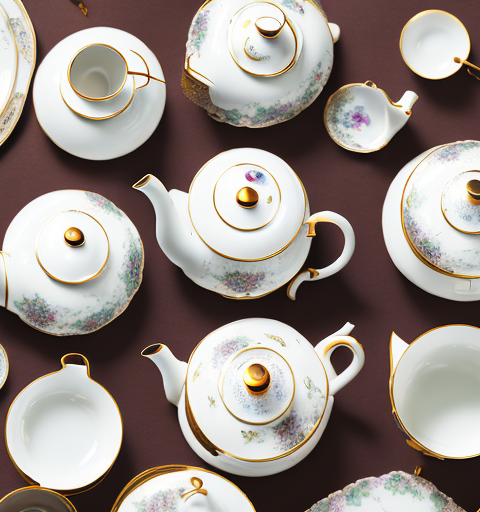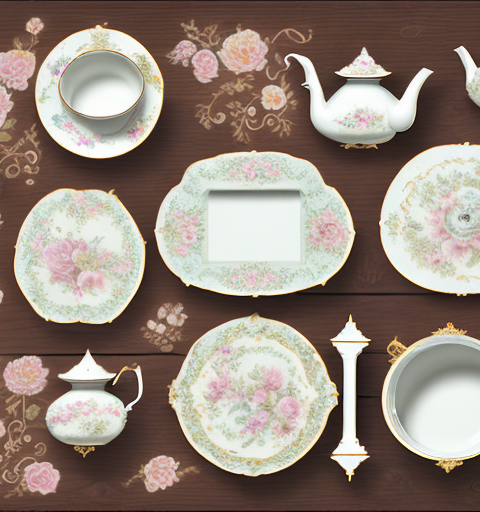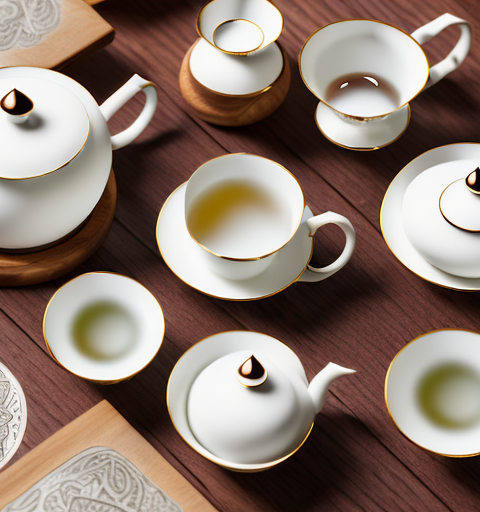Ceramic teapots are not only functional but also beautiful pieces that can enhance your tea-drinking experience. However, one of the biggest concerns for ceramic teapot owners is the risk of chipping. Chipping not only damages the aesthetic appeal of the teapot but can also render it unusable. In this article, we will explore various measures to prevent chips in ceramic teapots and ensure their longevity.
Understanding the importance of preventing chips in ceramic teapots
Preventing chips in ceramic teapots is essential for maintaining their functionality and preserving their beauty. Chipping can weaken the structure of the teapot, making it more prone to further damage. Additionally, chipped edges can be sharp and pose a risk of injury while handling. By taking proactive measures to prevent chips, you can extend the lifespan of your teapot and enjoy it for years to come.
One way to prevent chips in ceramic teapots is to handle them with care. Avoid banging the teapot against hard surfaces or other objects, as this can cause chips or cracks. When washing the teapot, use a soft sponge or cloth to gently clean the surface, rather than scrubbing vigorously. This will help to prevent any accidental damage to the ceramic.
Another important factor in preventing chips is proper storage. When not in use, store your teapot in a safe place where it won’t be at risk of being knocked over or bumped into. Consider using a padded or lined storage box to provide extra protection. Additionally, avoid stacking other items on top of the teapot, as this can put unnecessary pressure on the ceramic and increase the risk of chipping.
The common causes of chipping in ceramic teapots
There are several factors that can contribute to chipping in ceramic teapots. One common cause is accidental impacts. Dropping or banging the teapot against a hard surface can result in chips or cracks. Another cause is exposure to extreme temperatures, which can cause the ceramic to expand or contract rapidly, leading to damage. Additionally, improper handling, inadequate storage, and poor maintenance can also contribute to chipping over time.
Furthermore, the quality of the ceramic used in the teapot can also play a role in its susceptibility to chipping. Lower quality ceramics may be more prone to chipping due to their composition or manufacturing process. It is important to choose a teapot made from high-quality ceramic to minimize the risk of chipping.
Choosing the right type of ceramic for a durable teapot
When selecting a ceramic teapot, it is crucial to consider the type of ceramic used. Certain types of ceramics, such as porcelain or stoneware, are known for their durability and chip-resistant properties. These materials have a higher resistance to impacts and thermal changes, making them less likely to chip. Investing in a teapot made from high-quality ceramic can significantly reduce the risk of chipping and increase its overall longevity.
Another important factor to consider when choosing a ceramic teapot is the glaze used on the surface. A high-quality glaze not only enhances the aesthetic appeal of the teapot but also provides an additional layer of protection against chipping and staining. Look for teapots with a smooth and even glaze that is free from any cracks or imperfections. This will ensure that the teapot is more resistant to daily wear and tear, and will maintain its beauty for a longer period of time.
Proper handling techniques to avoid chipping
Handling your ceramic teapot with care is key to preventing chips. Always hold the teapot using both hands, ensuring a secure grip to minimize the risk of accidental drops. Avoid placing excessive weight or pressure on the teapot, especially when it is filled with hot liquid. When using utensils to stir or pour, opt for wooden or silicone tools that are gentle on the teapot’s surface. By practicing proper handling techniques, you can significantly reduce the chances of chipping.
In addition to proper handling techniques, it is also important to store your ceramic teapot correctly. When not in use, it is recommended to store the teapot in a safe and secure location, away from other objects that could potentially cause damage. Avoid stacking other items on top of the teapot, as this can increase the risk of chipping. Additionally, consider using a protective cover or wrapping the teapot in a soft cloth to provide an extra layer of protection. By taking these precautions, you can further prolong the lifespan of your ceramic teapot and keep it in pristine condition.
The impact of temperature changes on ceramic teapot durability
Temperature changes can have a significant impact on the durability of ceramic teapots. Avoid subjecting your teapot to sudden temperature extremes, such as placing a hot teapot directly on a cold surface or vice versa. Thermal shock caused by rapid temperature variations can cause the ceramic to crack or chip. To minimize this risk, use a trivet or tea cozy to insulate the teapot and gradually adjust its temperature when exposed to hot or cold environments.
It is also important to note that ceramic teapots should not be placed in the freezer or exposed to extreme heat sources, such as open flames or stovetops. Freezing can cause the ceramic to become brittle and prone to breakage, while direct exposure to high heat can lead to warping or discoloration. To ensure the longevity of your ceramic teapot, always handle it with care and avoid subjecting it to extreme temperature conditions.
How to store your ceramic teapot safely to prevent chips
Proper storage is crucial to protect your ceramic teapot from potential chips. When not in use, store the teapot in a secure and stable location, away from the edges of countertops or shelves where it may be accidentally knocked off. Avoid stacking other items on top of the teapot, as this can increase the risk of damage. If storing multiple teapots, consider using soft padding, such as felt or cloth, to separate them and prevent any accidental collisions.
Another important factor to consider when storing your ceramic teapot is the temperature and humidity of the storage area. Extreme temperature changes can cause the teapot to expand or contract, leading to cracks or chips. It is best to store your teapot in a cool, dry place to minimize the risk of damage.
In addition, it is recommended to clean and dry your teapot thoroughly before storing it. Any leftover moisture can promote the growth of mold or mildew, which can be detrimental to the ceramic material. Make sure to wipe the teapot dry with a soft cloth and allow it to air dry completely before placing it in storage.
Cleaning and maintenance tips for chip-free ceramic teapots
To maintain a chip-free ceramic teapot, it is important to follow proper cleaning and maintenance practices. Always hand wash your teapot using mild dish soap and a soft sponge or cloth. Avoid using abrasive cleaners or scrub brushes that can scratch the surface and weaken the ceramic. After washing, ensure the teapot is completely dry before storing it to prevent moisture-related damage. Regularly inspect the teapot for any signs of wear or damage, addressing them promptly to prevent chips from worsening.
In addition to regular cleaning, there are a few extra steps you can take to ensure the longevity of your chip-free ceramic teapot. One important tip is to avoid exposing the teapot to extreme temperature changes. Rapid shifts in temperature can cause the ceramic to expand or contract, increasing the risk of chipping. To prevent this, allow the teapot to cool down before washing it with cold water or placing it in the refrigerator.
Another helpful tip is to handle the teapot with care when using it. Avoid banging it against hard surfaces or placing it in a crowded sink where it may come into contact with other dishes or utensils. Additionally, when pouring hot liquids into the teapot, be mindful of the pouring angle to prevent any accidental impacts that could lead to chipping.
Exploring protective coatings for ceramic teapots
There are various protective coatings available in the market that can provide an additional layer of defense against chips in ceramic teapots. Ceramic sealants or glazes specially formulated for teapots can enhance their durability and chip resistance. These coatings create a barrier that helps prevent moisture absorption and protects the ceramic from impacts. Before applying any protective coating, carefully read and follow the manufacturer’s instructions to ensure proper application and effectiveness.
One popular type of protective coating for ceramic teapots is a clear, high-gloss glaze. This glaze not only adds a layer of protection but also enhances the appearance of the teapot, giving it a shiny and polished finish. It is important to choose a glaze that is food-safe and non-toxic, as it will come into contact with hot water and potentially be ingested.
In addition to glazes, there are also spray-on ceramic coatings available for teapots. These coatings are typically easy to apply and provide a thin, invisible layer of protection. They are designed to be heat-resistant and can withstand the high temperatures of boiling water. However, it is important to note that these spray-on coatings may need to be reapplied periodically to maintain their effectiveness.
Why investing in a teapot cozy can help prevent chips
A teapot cozy is a simple yet effective accessory that can help prevent chips in ceramic teapots. Made from insulating materials such as fabric or neoprene, a cozy helps to maintain a consistent temperature inside the teapot, reducing the risk of thermal shock. Additionally, the cozy provides a cushioning effect, protecting the teapot from accidental impacts. Investing in a teapot cozy not only adds a touch of elegance but also helps extend the lifespan of your ceramic teapot.
The role of proper pouring techniques in preventing chipping
Proper pouring techniques play a significant role in preventing chipping in ceramic teapots. When pouring, hold the teapot securely and tilt it slowly to control the flow of liquid. Avoid excessive force or sudden jerky movements that can cause the spout to hit the edge of the cup or teapot lid. By mastering the art of controlled pouring, you can minimize the risk of chipping and enjoy a smooth and graceful tea-drinking experience.
Identifying signs of potential chip damage in ceramic teapots
Regularly inspecting your ceramic teapot for potential chip damage is essential in preventing further deterioration. Look for any visible cracks, chips, or rough edges along the rim, handle, or spout. Even small chips can develop into larger cracks if left unaddressed. If you notice any sign of chip damage, it is advisable to stop using the teapot immediately and take appropriate measures to repair or replace it, depending on the severity of the damage.
Repairing minor chips in ceramic teapots: A step-by-step guide
If you discover minor chips in your ceramic teapot, you may be able to repair them yourself with a few simple steps. Begin by thoroughly cleaning the affected area and removing any loose ceramic fragments. Apply a food-safe ceramic adhesive or epoxy to the chip, following the manufacturer’s guidelines. Gently press the chip back into place and hold it firmly until the adhesive dries. Once the repair is complete, ensure the teapot is fully cured and wash it before using it again.
Expert advice for preventing chips in antique ceramic teapots
When it comes to preventing chips in antique ceramic teapots, seeking expert advice is highly recommended. Antique teapots may be more fragile and delicate compared to modern counterparts. Consulting with a professional antique dealer or collector can provide insights on proper care, handling, and storage specific to antique teapots. Their expertise can help you avoid potential pitfalls and ensure the long-term preservation of these valuable pieces.
Comparing different materials for teapots and their susceptibility to chipping
While ceramic teapots are popular choices, it’s worth exploring other materials and their susceptibility to chipping. For instance, teapots made from cast iron or stainless steel may offer higher resistance to chipping due to their durability and robustness. However, these materials may have different thermal properties and require specific care instructions. Understanding the pros and cons of different teapot materials can help you make an informed decision based on your preferences and priorities.
Understanding the impact of water quality on ceramic teapot longevity
The quality of water used in your ceramic teapot can also have an impact on its longevity. Hard water with a high mineral content can cause mineral deposits to build up on the teapot’s surface over time. These deposits can create a rough texture that weakens the ceramic and makes it more susceptible to chips. Using filtered or bottled water can help reduce mineral deposits and prolong the lifespan of your teapot.
Exploring innovative design features that can reduce chipping risks
Teapot manufacturers are continuously innovating design features that help reduce the risks of chipping. Look for teapots with reinforced handles, sturdy spouts, and thicker rims, as these design elements can enhance the teapot’s durability. Some teapots also incorporate shock-absorbing mechanisms or materials that provide additional protection against impacts. Exploring the market for teapots with innovative design features can help you find a style that suits your taste while minimizing the risk of chips.
Tips for transporting your ceramic teapot without risking damage
Transporting a ceramic teapot requires careful consideration to avoid any potential damage. When traveling with a teapot, ensure it is securely packed in a padded or cushioned bag, preferably with individual compartments. This prevents the teapot from moving or colliding with other items during transport. If possible, keep the teapot in its original packaging to provide an additional layer of protection. Handle the transportation with care, avoiding any rough movements or impacts.
How to handle cracked or damaged ceramic teapots to avoid further chips
If your ceramic teapot has developed cracks or sustained significant damage, it is important to handle it correctly to avoid further chips. Avoid using the teapot for brewing or pouring hot liquids, as the cracks may allow seepage or leakage. Instead, repurpose the teapot for decorative or storage purposes. Handle the teapot gently, ensuring it is stored in a stable position where it is less likely to sustain additional damage. Repair or replace the teapot as appropriate to prevent any further deterioration.
Frequently asked questions about preventing chips in ceramic teapots
Q: Can I use a chipped teapot?
A: It is not recommended to use a chipped teapot, as it can pose a risk of injury and further damage.
Q: Can I repair a severely chipped teapot?
A: Severely chipped teapots are often difficult to repair effectively. It is advisable to consult a professional or consider replacing the teapot.
Q: How often should I inspect my teapot for potential chip damage?
A: Regular inspections are recommended, preferably every few months or whenever you notice any changes in the teapot’s appearance or functionality.
Q: Are all ceramic teapots equally susceptible to chipping?
A: No, the susceptibility to chipping can vary depending on factors such as the quality of the ceramic, design features, and proper care and maintenance.
Q: Can I prevent all chipping in a ceramic teapot?
A: While it may not be possible to prevent all chipping entirely, following proper care and handling techniques can significantly reduce the risk of damage.
With these tips and precautions in mind, you can enjoy your ceramic teapot without worrying about chips or compromises in its functionality and aesthetic appeal.






